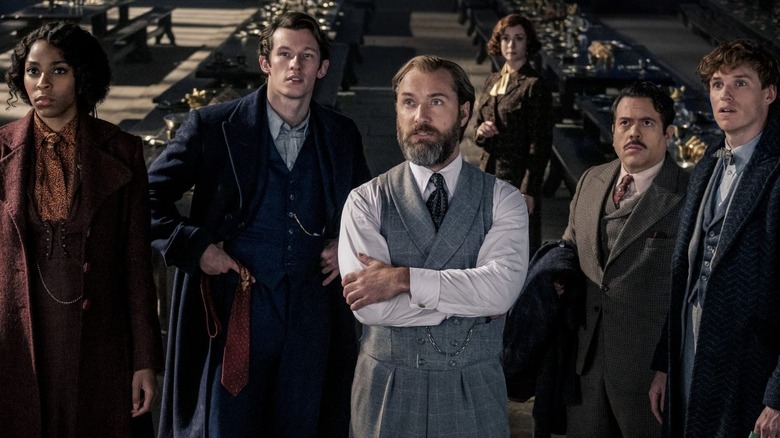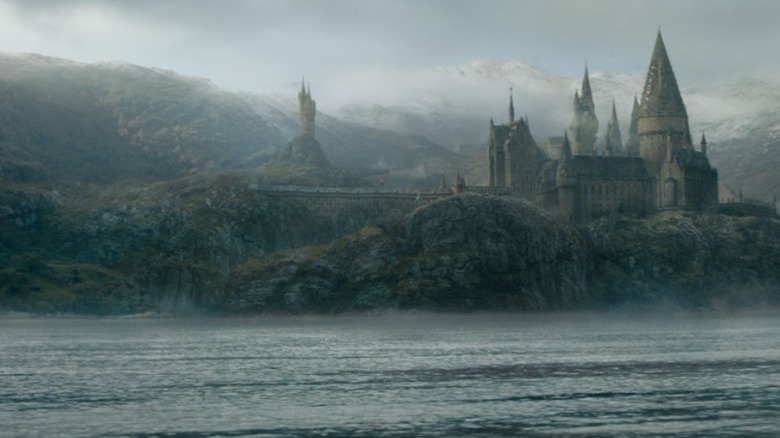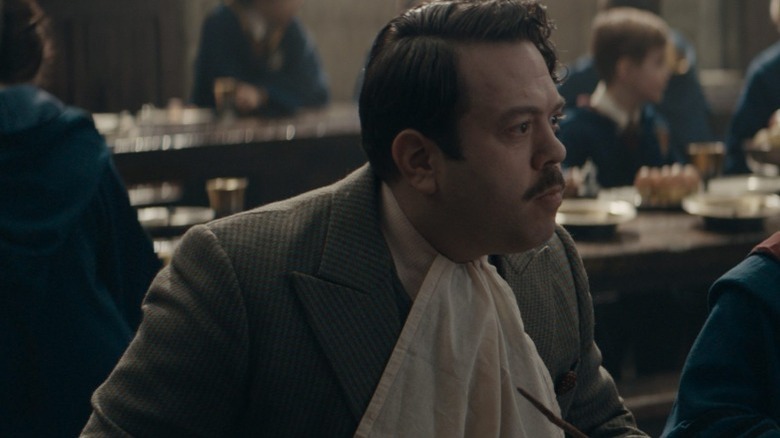Fantastic Beasts: The Secrets Of Dumbledore Had To Recreate Staple Harry Potter Sets With VFX
With the "Harry Potter" movies, one thing was always certain: the magical school for witches and wizards, Hogwarts, would be cozy. This was home for the heroes, who would fall in love, fail classes, and nearly die there — it was important that the audience feel the same affection for the location that they did. Within its walls, there would be moving staircases, hallways to nowhere, and ghosts, but more importantly, a rich and evocative sense of life orchestrated by production designer Stuart Craig. Even as the movies got darker and different directors came on board, Hogwarts retained its sense of wonder and comfort.
The 1920s-set "Harry Potter" prequel series, "Fantastic Beasts," does not involve Hogwarts in the same way. The protagonists are all adults, long past school-aged, and the conflict with which they wrestle is a complex and global one. Where Hogwarts was at the center of nearly every "Harry Potter" movie, it's been pushed to the margins for these movies. Exotic locales and eerie reconstructions of early 20th-century Paris and New York have taken over much of the movies' locations, which might be one part of why the magic in the series has seemingly disappeared.
Hogwarts is still around. If the movies' plots are going to be overstuffed, why shouldn't there be a little detour to the familiar, beloved school? The only problem is that many of the old "Harry Potter" sets have disappeared. The "Fantastic Beasts" team has had to get creative in bringing back Hogwarts.
Why bring back Hogwarts?
It's hard to say what in particular led to the public disinterest around the "Fantastic Beast" series (this article digs into many of the possible factors), but the fact remains that it has little of the goodwill generated by the larger "Harry Potter" (or "Wizarding World") franchise. Per The Numbers, the latest entry, "The Secrets of Dumbledore," has earned less domestically than any other film in the series.
Still, resurrecting Hogwarts is a significant step towards regaining that goodwill, even if it adds a wrinkle to the narrative in getting there. Professor Albus Dumbledore (Jude Law) spends most of his off hours engineering complex plots to take down former lover/current enemy Gellert Grindelwald (Mads Mikkelsen), who is scheming to conquer the Wizarding World. In "Fantastic Beasts: TheSecrets of Dumbledore," Hogwarts functions as a kind of refuge, a place for the characters to go when things are looking dark.
While the sets have disappeared, and it's been a decade since the last mainline "Harry Potter" film, the art department had some luck in terms of securing reference material. Following that series' conclusion, many of the original backlots and miniatures that comprised our visual understanding of Hogwarts were sent in perpetuity to Leavesden, to the Warner Bros. Studio Tour London – The Making of Harry Potter. That ended up being extremely valuable to "The Secrets of Dumbledore."
Touchstones
One of the big challenges was ensuring that the Hogwarts of the new films both echoes the design with which viewers are familiar (particularly in the massive, inviting Great Hall) as well as match the aesthetic of the new films. Somehow, with the production design by franchise veterans Neil Lamont and Stuart Craig, the film succeeded. Craig knew Hogwarts well – he claimed in FilmCraft that after the wildly successful first movie, "Harry Potter and the Sorcerer's Stone," he "spent the next 10 years revisiting [the Hogwarts] skyline film by film and making all sorts of improvements along the way."
Per SnapTaste, the art department and the VFX department on the film also benefited from the "Harry Potter" tour at Leavesden. VFX Supervisor Christian Manz credits the exhibit for giving them the necessary tools to create digital scans of these familiar environments to use for the final film.
As Manz says in this making-of clip, "the touchstone for seeing something like the Great Hall is how we see it in 'Harry Potter.'" To see the Great Hall scenes in "The Secrets of Dumbledore," they may well be on the old-school physical sets from the "Harry Potter" films rather than digital recreations. That makes it all the more impressive seeing how bare the set they filmed on was, with so little of the familiar iconography.
Production and post-production
According to Christian Manz, the VFX Supervisor for "Secrets of Dumbledore," "the vast amount of digital extension needed to bring The Great Hall and Room of Requirements at Hogwarts back to the screen" was completed by effects studio One Of Us. The production design worked in tandem with the visual effects team, building what Production Designer Neil Lamont called "a proxy set" that would provide both the effects team and the on-set cast and crew a strong sense of place.
From there, they had other tools, such as the use of VR program fARsight. Per IndieWire, this tool allowed for a great amount of pre-planning with director David Yates on the look of scenes and on camera moves — it also allowed for immediate dialogue between the production team and the post-production team, ensuring a seamless aesthetic unity. In doing so, they avoided some of the pitfalls common to VFX-reliant modern blockbusters.
For all of the fantastical locations visited in "Secrets," from a German wizard prison with crustacean monsters to the Bhutanese mountains wherein a wizarding election is being held, Hogwarts' restoration may be one of the most impressive.



